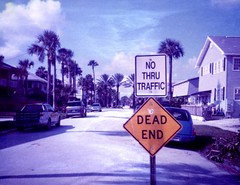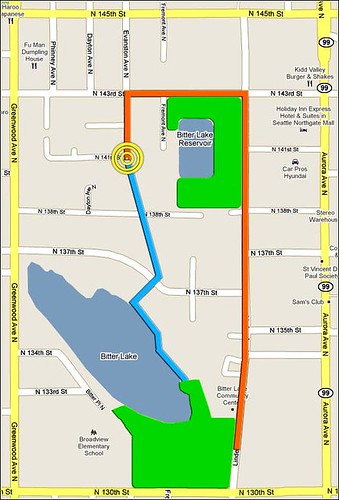Walkability 101-B, or why it's good to be connected

Posted May 11, 2010 at 2:11PM
The degree to which our streets connect with each other has a major impact on how our communities feel and function, and a major effect also on their walkability. Generally speaking, the more connections (more frequent intersections, smaller block sizes) the better for making travel routes more efficient and attractive. This allows the substitution of walking or bicycling for some trips that in a disconnected neighborhood would be made by car, and it also shortens driving distances, reducing emissions in the process. Being connected is a good thing when it comes to neighborhoods.
I’ve written about this subject before, and so has my colleague Rachel Sohmer. I am returning to it now because David Roberts of Grist has written one of the best lay person’s explanations I have seen of how connectivity can work to improve a community, using his own neighborhood in Seattle as an example.
Look at the maps above. The one on the left shows David’s house in relation to existing neighborhood streets and a couple of parks. The one on the right shows the circuitous route (indicated in orange) he must take to get to the park at the southern end of the neighborhood. The park isn’t that far away as the crow flies (does Seattle have crows?), but it might as well be. The same map also shows (in blue) how the route could be shortened and made more direct if the neighborhood streets were better connected.
David explains the result:
“The seemingly small difference between the blue and orange routes is enough to make a fairly large difference is our daily life: we just don't go to the park much, and thus don't interact with the other [neighborhood residents] who spend time there . . .
“The map doesn't show it well, but see that spur of Dayton Ave N that juts off 138th? The houses on that little cul de sac are within a stone's throw of my place. There may be all sorts of groovy people living there, but we'll never know, because to get there we have to go north to 143rd, west to Greenwood, south to 138th, and east to Dayton. Suffice to say: we wouldn't do that unless we already knew someone there, and we'd never meet anyone there unless we did it. So we don't.”
In the next two maps, David shows how he might redesign the street pattern if he could (his post is amusingly subtitled “wherein I play God”) and, in the map on the right, how he might improve the two parks in his neighborhood as well, by creating park buffers around the reservoir and the lake. It’s really a great post, with better and more complete explanations than I am giving you here, and I urge you to read it.
In addition to David's article, Ania Wieckowski reports in the Harvard Business Review on research by Dr. Lawrence Frank at the University of British Columbia confirming that connected streets reduce driving. Residents in metro Seattle areas with the most interconnected streets were found to travel 26% fewer vehicle miles than those in areas with many cul-de-sacs. Wieckowski also notes that recent studies show that as a neighborhood’s overall walkability increases,  so does the amount of walking and biking—while, per capita, air pollution and body mass index decrease.
so does the amount of walking and biking—while, per capita, air pollution and body mass index decrease.
Even though some people think disconnected, cul-de-sac street patterns are safer, research shows that belief to be misplaced. If well designed, connected streets can in fact be safer than cul-de-sacs. Reporting on the same research by Frank, Melissa Lafsky adds in The Infrastructurist, "the theory behind cul-de-sacs was that they lessened traffic, since they change the primary function of local streets — rather than offering a way to get anywhere, now they simply provide access to private residences. The problem is that this design inherently encourages car use, even for the shortest trips." Moreover, emergency response times are shorter in connected neighborhoods with more direct routes if your community needs a fire truck, police car, or ambulance, which I hope it doesn’t.
It’s difficult to go back and repair planning mistakes that we made a long time ago, but we can certainly learn from experience and do a better job as we plan newer neighborhoods. And there are things we can do to repair existing places, too, by starting modestly with foot paths, for example. Many thanks to David for reminding us why.
Move your cursor over the images for credit information.



